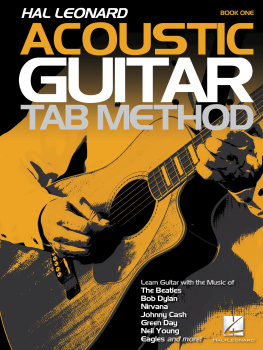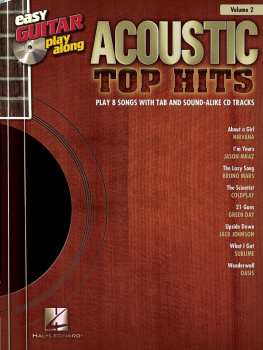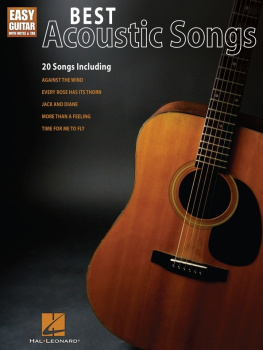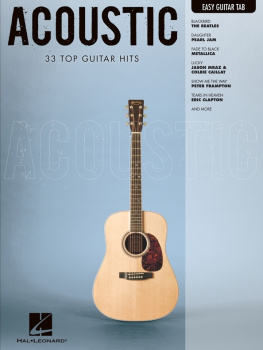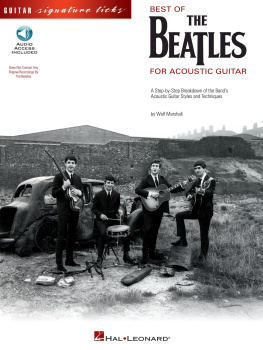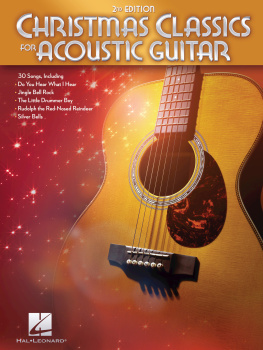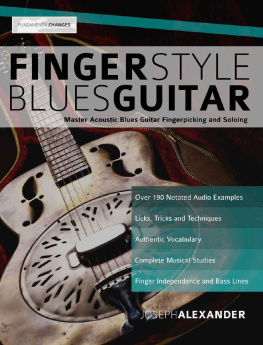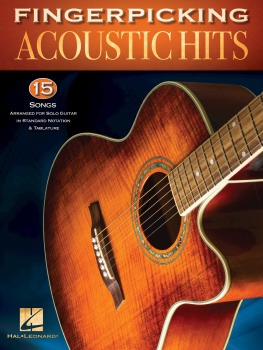Acoustic Guitar for Beginners
The Ultimate Beginners Guide to Learn the Realms of Acoustic Guitar from A-Z
Copyright 2020 - All rights reserved.
The content contained within this book may not be reproduced, duplicated or transmitted without direct written permission from the author or the publisher.
Under no circumstances will any blame or legal responsibility be held against the publisher, or author, for any damages, reparation, or monetary loss due to the information contained within this book, either directly or indirectly.
Legal Notice:
This book is copyright protected. It is only for personal use. You cannot amend, distribute, sell, use, quote or paraphrase any part, or the content within this book, without the consent of the author or publisher.
Disclaimer Notice:
Please note the information contained within this document is for educational and entertainment purposes only. All effort has been executed to present accurate, up to date, reliable, complete information. No warranties of any kind are declared or implied. Readers acknowledge that the author is not engaging in the rendering of legal, financial, medical or professional advice. The content within this book has been derived from various sources. Please consult a licensed professional before attempting any techniques outlined in this book.
By reading this document, the reader agrees that under no circumstances is the author responsible for any losses, direct or indirect, that are incurred as a result of the use of information contained within this document, including, but not limited to, errors, omissions, or inaccuracies.
Table of Contents
Introduction
As a beginner, one of the most recommendable types of guitar to start with is the acoustic guitar. An acoustic guitar is characterized by the presence of a sound box, which amplifies the sound of the strings. With an acoustic guitar, you don't need an amplifier or speakers to produce a solid sound. As such, you can easily pick up an acoustic guitar and practice anywhere. Acoustic guitars produce a soulful and beautiful sound, making it quite a versatile instrument usable in so many music genres. So, wanting to learn how to play an acoustic guitar might just be one of the coolest instruments you will learn this year.
As we know it, the guitar is about a century old or older, and the root as a stringed instrument goes deep into history. For thousands of years many folk instruments followed the same basic design of strings stretched over the fretboard and plucked with the fingers. In a way, the guitar is the culmination of that legacy, hence the guitar's versatility. As long as you're a guitar lover, you'd find this book quite useful. No matter your experience, situation, or motives, the goal of this book is to provide you with enough information so that you can explore everything on your own.
It is common for beginners to feel as though they are stuck at a certain point in their guitar learning. With this beginner's guide, we will enlighten you with exceptional methods that will skyrocket your learning curve. Understanding what you can do with the guitar, finding new ways to make new sounds, and a better grasp of how to fret notes and chords that seemed impossible before becomes tremendously exciting and satisfying. All these await you as long as you are willing to put in some time and effort to understand everything this book entails.
We don't assume you know anything about playing a guitar or reading music. So, for you to understand everything about playing the guitar from scratch. We start this guide from the basics to make comprehension easier. And with the straightforward, informal explanation of how guitars work, the different types of guitar, and how you can play, form chords, strum, and fingerpick strings, you can overall deepen your knowledge in so many directions. Without any further introduction, let us start with guitar history and work our way to something more advanced.
Chapter 1: History and Types of Guitar
To start this beginner's guide on how to play an acoustic guitar, let us take a little detour to the history of guitars. We find this particularly important to discuss it first because it is always best to know where it all began. Guitars are widely played in so many countries, folk and popular music, which resulted in the multiple origin stories we all hear when we ask where the guitar was born. Depending on who you ask, the story of the guitar's birth stretches from Persia to Greece. Perhaps it was born in all this region, but in variations of strings, plucked instruments found worldwide, indicating the ingenuity and creativity that transcends culture.
History of the Guitar
The guitar is a string instrument that originated from Spain in the early 16th century. What we now know as the guitar is an instrument derived from the late-medieval instrument, Guitarra Latina. The Guitarra Latina is a four-string instrument. The earliest forms of guitars had a less pronounced waist, narrower and deeper than the guitars we see today. Guitarra Latina is in a lot of aspects related to the Vihuela. Vihuela is an instrument shaped like a guitar that is mainly played in Spain instead of the Lute. Earlier guitars had only four strings; three doubles and a single top string. The strings were glued and stretched from the tension bridge to the soundboard or belly of the guitar, like in the case of the violin peg-box. The bridge sustains the direct pull of the strings. You will also find a circular sound hole in the guitar's belly, often ornamented with a carved wooden rose.
Most of the improvements we see on the guitar today were made between the 16th and 19th centuries. In the 16th century, the four strings of guitars were tuned to sound C-F-A-D apart, like tuning the center four courses of the Vihuela and the Lute. Before 1600, a 5th string was added to the guitar, and in the late 18th century, the 6th string was added. Around the year 1800, music inventors replaced the guitar's double strings with a single string, making the guitar tune to E-A-D-G-B-E, which to date remained the standard for tuning the guitar.
Another improvement done on the guitar was sometime in 1600 when the violin-styled peg-box was replaced with a flat and slightly reflexed head with rear tuning pegs. Later on, in the 19th century, inventors came up with metal screws in place of the tuning pegs. Previously, the frets were tied to the guitar's gut, but it was later replaced with ivory or metal fret in the 18th century. Originally, the fingerboard was flush with the belly and ended there, with some ivory or metal frets on the belly. Later in the 19th century, more development was done on the fingerboard, raising it to a level higher than the belly, causing it to extend across the edge of the sound hole.
Additionally, in the 19th century, the guitar's body went through a couple of changes, which increased the instrument's sonority. This improvement caused the guitar to become broader and shallower with an extremely thin soundboard. Likewise, the transverse bars that internally reinforce the soundboard were replaced with radial bars fanning out below the sound hole. Also, the guitar's neck forms a brace or shoe, which projects a short distance inside the body of the guitar, and it is glued to the back. This development gave the guitar extra stability against the pull of the string.
So, it's no doubt that the guitar or the instruments related to the guitar have existed since ancient times. The idea of a stretched string vibrating over a chamber of air called the sound box is not a new idea. This idea dates back to prehistoric times founded in so many cultures in the world. The use of frets to mark the tones to scale the sound most likely originated in India. Later on, early explorers from Portugal and Spain probably brought the idea of the guitar to Europe, and European settlers brought it to America.






